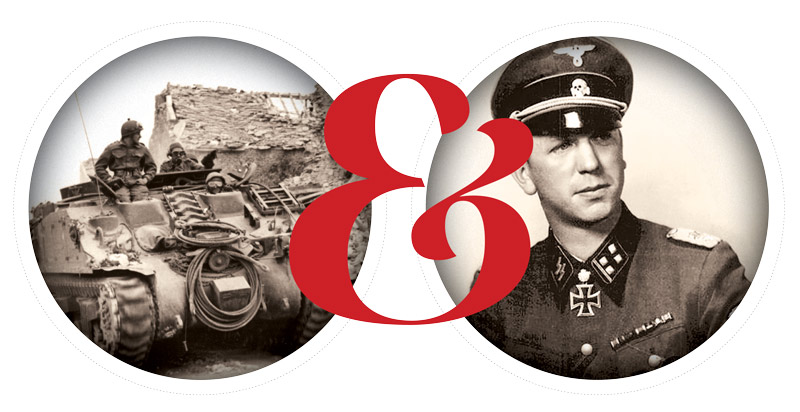Canadian PoWs
At 7:40 a.m. on June 7, 1944, the North Nova Scotia Highlanders supported by tanks of Les Fusiliers de Sherbrooke struck out from near Villons-les-Buissons to seize what had been the final Canadian June 6—D-Day—objective. The column was to race 8.5 kilometres through Buron and Authie to Carpiquet airfield. Almost immediately, the North Novas and Sherbrookes were hit by a 12th SS Panzer Division (Hitlerjügend) counterattack directed by Standartenführer Kurt Meyer.
The Canadian force was shredded. Many soldiers were taken prisoner and the fanatical Hitler Youth embarked on a random spree of murders through to June 11 that claimed the lives of 156 Canadian prisoners. At Authie, 37 soldiers were executed. Others were butchered at Buron and other locations or killed while being marched to the garden of the Abbaye d’Ardenne. The latter consisted of a Gothic church and several buildings enclosed within walls. Meyer had established his local headquarters here given that the church’s towers provided excellent observation beyond the Canadian front line to Juno Beach.
Interrogated in turn, each soldier was executed afterward.
While the Canadians in the compound were being formed into a column on June 7 to march to a holding pen at Bretteville-sur-Odon, German military police picked 10 at random and locked them in a room already occupied by a badly wounded North Nova, Lance Corporal Hollis McKeil.
Interrogated in turn, each soldier was executed afterward. Six had their heads smashed in with a cudgel, while the other five were killed by a gunshot to the head. Four had served in the same Sherbrooke tank—Lieutenant Thomas Windsor and troopers James Bolt, Harold Philip and Roger Lockhead—while two other Sherbrookes were among the murdered. The rest were North Novas.
The killing at the compound continued. On June 8, near noon, seven West Novas captured in fighting around Authie and Buron were interrogated, then taken to the garden where they were shot in the back of the head with machine pistols. It’s also believed that on June 17 two more Canadians—both Stormont, Dundas and Glengarry Highlanders—were executed here.
A monument was unveiled at the site on D-Day’s 40th anniversary. Its inscription reads: “On the night of 7/8 June 1944, 18 Canadian soldiers were murdered in this garden while being held as prisoners of war. Two more prisoners died here or nearby on June 17. They are dead but not forgotten.”
KURT Meyer
From an Abbaye d’Ardenne church tower, Standartenführer Kurt Meyer watched Canadian infantry and tanks advance toward Carpiquet airfield. Commanding the 12th SS Panzer Division (Hitlerjügend)’s 25th Panzergrenadier Regiment, Meyer was directing operations aimed at stopping the Canadian D-Day advance. The 33-year-old Nazi unquestioningly believed in the Aryan race’s superiority. He was confident his mostly teenaged soldiers could throw the “little fish back into the sea.”
During the night, Meyer had readied his battalions to push back. On June 7, however, the Canadians were moving through Buron toward Authie in an obvious thrust to the airport. “My God! What an opportunity!” Meyer later wrote. “The tanks are driving right across II Battalion’s front! The Unit is showing its unprotected flank. I give orders to all battalions, the artillery and the available tanks. ‘Do not shoot! Open fire on my orders only!’”
Minutes later, Meyer unleashed II Battalion to drive the advancing force back to Authie. After that, he would commit the rest of the 25th Regiment’s battalions. “The objective. The coast,” he declared. Just as Meyer planned, a pitched battle overwhelmed the North Nova Scotia Highlanders and supporting Sherbrooke Fusiliers.
Large numbers of Canadian prisoners were soon gathered at the Abbaye d’Ardenne. On the battlefield, meanwhile, many surrendering Canadians were being murdered. Some of this slaughter was perhaps spurred by Meyer having reportedly told his soldiers just before the invasion they should use the coming battles to retaliate for Allied bombing of German cities.
He was confident his mostly teenaged soldiers could throw the “little fish back into the sea.”
The first round of murders at the abbey happened close to the room from which Meyer was directing operations. It’s not known if he was aware of these killings. On June 8, however, seven North Novas were marched by two SS troopers into the compound. When these soldiers reported to Meyer, he angrily asked: “What should we do with these prisoners? They only eat up our rations.”
After whispering instructions to another officer, Meyer loudly announced: “In the future no more prisoners are to be taken!” The seven Canadians were murdered in the abbey’s garden.
At a trial in December 1945, Meyer was convicted of responsibility for some of these murders and sentenced to death. The punishment was subsequently commuted to life imprisonment. In 1951, however, Meyer was transferred from a Canadian prison to one in West Germany, then released on Sept. 7, 1954. He died in 1961.
Advertisement






















